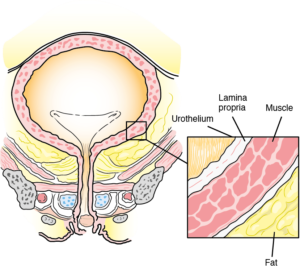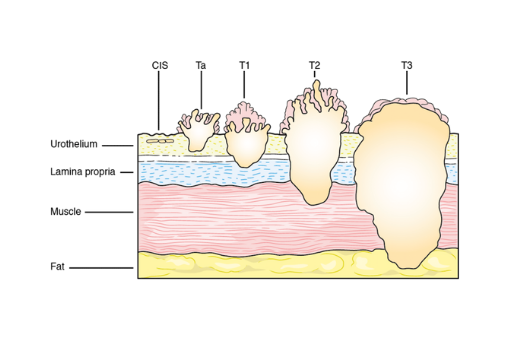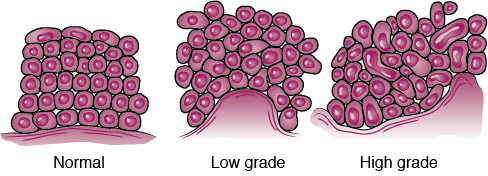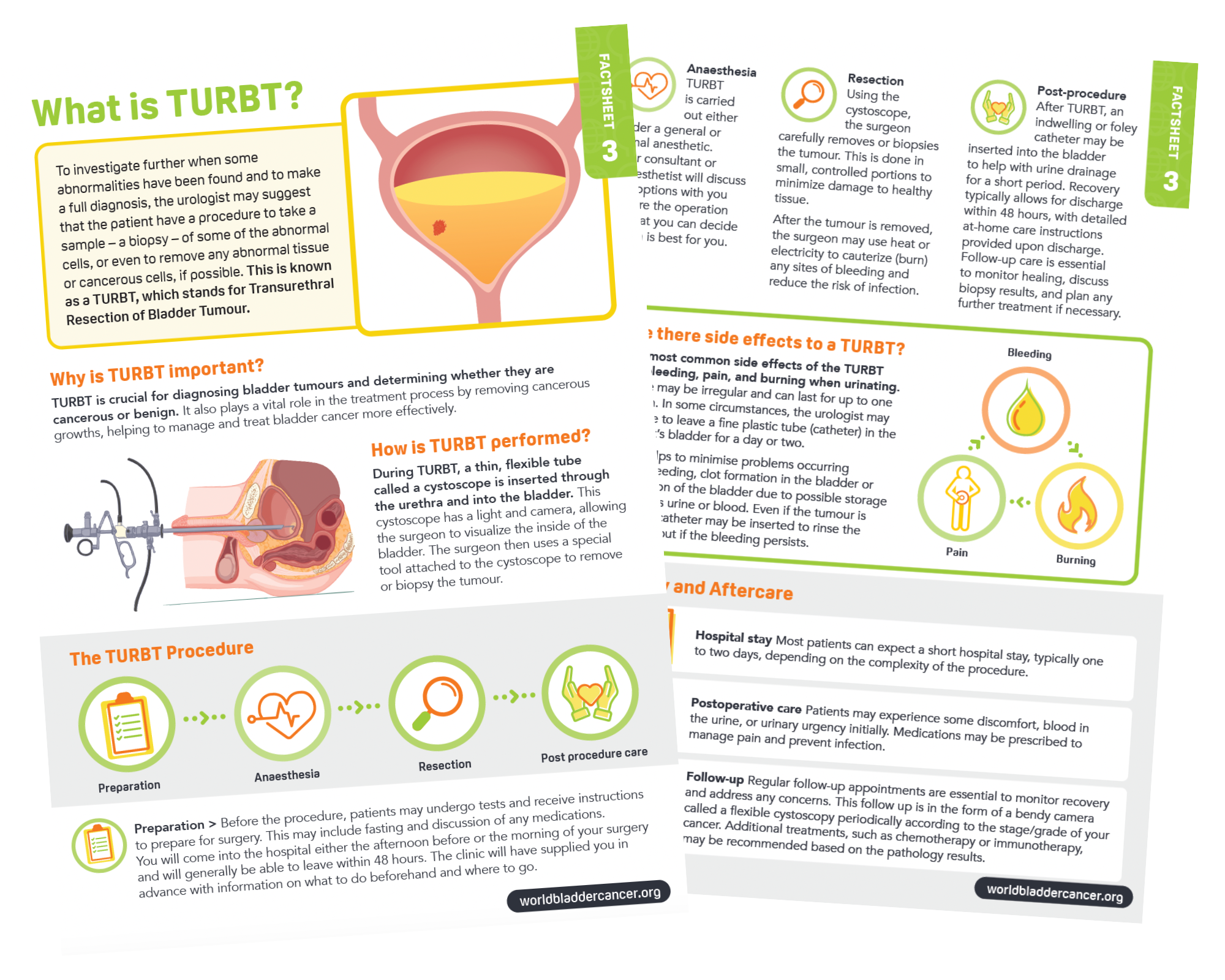What is Bladder Cancer?
Cancer occurs when cells in the bladder start to grow out of control. Most tumours develop on the inner layer of the bladder. Some can grow into the deeper bladder layers. As cancer grows through these layers into the wall, it becomes harder to treat. The lining, where tumours initiate, is also found in the inner layers of the kidneys, ureters, and urethra. So, similar cancers can occur in these areas, though much less frequently.
What does your bladder do?
Your bladder is part of your urinary system. The job of the urinary system is to filter waste products from your blood and transport the waste products or urine, out of your body. The diagram below shows the organs of the urinary system. Most of the urinary tract is lined with a special layer of cells called transitional cells. The primary “machines” in the human filtering system are the two kidneys located close to the backbone and protected by the ribs. The kidneys work independently. They have the significant task of filtering approximately 20% of total blood volume each minute and removing the by-products of digestion and of other body functions.

Once produced, the urine (the filtered waste product) is stored in the central part of the kidney called the renal pelvis. At regular intervals, the renal pelvis contracts and propels the urine through the ureters. These narrow, thin-walled tubes extend from inside the renal pelvis to the bladder. The bladder is a thick-walled structure, consisting of a relatively thin inner layer with a thick muscle covering.
This inner layer or epithelium is made of several layers of cells. The epithelial layer is also called the transitional cell layer. The main function of the bladder is to store urine. For most people, the bladder can hold as much as 1 pint (almost 500ml) of urine at a time. It contracts or expands depending on how much fluid is in it. When it contracts following a series of neurological “messages” to the brain and spinal cord, the urine moves through the urethra outside the body.
What causes bladder cancer?
As with many types of cancer, one of the leading risk factors of the disease is smoking. Those who smoke may be up to four times more likely to get bladder cancer. People who work with certain chemicals may also be at risk – leather workers, hairdressers, mechanics and painters, among other occupations. Exposure to radiation has also been linked to bladder cancer. Caucasian men may also be at greater risk. But the simple truth is that many will develop bladder cancer for no known reason. You may be one of those people. At this point, asking “why” is not nearly as helpful as focusing on “what now .”
What are bladder cancer types, stages & grades?
Bladder cancer is commonly separated into slow-growing, non-invasive cancers and fast-growing invasive cancers. These are commonly called non-invasive bladder cancer (NMIBC) and invasive bladder cancer (MIBC). Scroll down to learn more about bladder cancer types, stages & grades.
Three types of bladder cancer may form, and each type of tumor can be present in one or more areas of the bladder, and more than one type can be present at the same time:
- Papillary tumors stick out from the bladder lining on a stalk. They tend to grow into the bladder cavity, away from the bladder wall, instead of deeper into the layers of the bladder wall.
- Sessile tumors lie flat against the bladder lining. Sessile tumors are much more likely than papillary tumors to grow deeper into the layers of the bladder wall.
- Carcinoma in situ (CIS) is a cancerous patch of bladder lining, often referred to as a “flat tumor.” The patch may look almost normal or may look red and inflamed. CIS is a type of nonmuscle-invasive bladder cancer that is of higher grade and increases the risk of recurrence and progression. At diagnosis, approximately 10% of patients with bladder cancer present with CIS.
While the majority of bladder cancers (approximately 90-95%) arise in the bladder, the urothelial cells that line the bladder are found in other locations in the urinary system. Sometimes these urothelial cancers can occur in the lining of the kidney or in the ureter that connects the kidney to the bladder. This is known as upper tract urothelial cancer (UTUC) correspond to a subset of urothelial cancers that arise in the urothelial cells in the lining of the kidney (called the renal pelvis) or the ureter (the long, thin tube that connects that kidney to the bladder). Learn more about UTUC on the BCAN website here.
If bladder cancer is diagnosed, the doctor needs to know the stage, or extent, of the disease to plan the best treatment. Staging is a careful attempt to find out whether the cancer has invaded the bladder wall, whether the disease has spread, and if so, to what parts of the body. Grade refers to what the cancer cells look like, and how many cells are multiplying. The higher the grade, the more uneven the cells are and the more cells are multiplying. Knowing the grade can help your doctor predict how fast the cancer will grow and spread.
Urologists typically send a sample of the cancer tissue to a pathologist, a doctor who specializes in examining tissue to determine the stage and grade of the cancer. The pathologist writes a report with a diagnosis, and then sends it to your urologist.
Stage suggests the location of the tumor in relation to the inner lining of the bladder. The higher the stage the further the tumor has grown away from its original site on the surface. The following are the stages for bladder tumors:
T0: No tumor
Ta: Papillary tumor without invading the bladder wall
TIS (CIS): Carcinoma in situ (non-invasive flat high-grade (G3) cancer)
T1: Tumour invades the connective tissue under the surface lining
T2: Tumour invades the muscle layer
T3: Tumour penetrates the bladder wall and invades the surrounding fat layer
T4: Tumour invades other organs (i.e., prostate, uterus, vagina, pelvic wall)

Grade is expressed as a number between 1 (low) and 3 (high, i.e. G3); the higher the number the less the tumour resembles a normal cell. In lieu of numbers to grade a bladder cancer tumour, your doctor may refer to the tumour simply as low or high grade.







